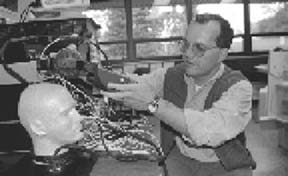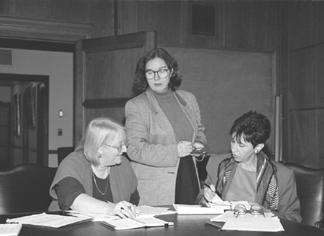The University Record, September 17, 1997
|
|
|
|
Bozidar Stojadinovic(left), assistant professor of civil and environmental engineering, has received Presidential Initiatives Fund support for a project on ‘Hazard Detection Using Augmented Reality.’ Abigail Stewart (right) received funding for ‘Redefining Censorship: Gender-based Restraints on Expression and Communication.’ With her are collaborators Marina Whitman (center) and Domna Stanton. Photos by Bob Kalmbach |
|
By Jane R. Elgass
Three faculty members have received Presidential Initiatives Fund awards in the most recent round of competition. In requesting proposals last year, then-President Homer A. Neal asked for projects that “highlight the relationship between undergraduate education and the active scholarly communities which makes us an exciting and dynamic research university.”
“These scholarly communities, comprised of individual research projects, programs, centers and institutes which bring faculty and student together in a shared process of discovery, add a critical dimension to the exceptional education available at the University of Michigan. While we have made great strides in incorporating undergraduates into these communities,” he continued, “my hope is that in the near future all students who wish to participate actively in the process of scholarly inquiry will have the opportunity. While not the sole criterion on which projects will be assessed, the extent to which undergraduates may be included in a proposal will favorably influence its evaluation.”
Final selection of the winners was made by President Lee C. Bollinger, who noted that all of them have the potential “to enhance the intellectual life of the University community.”
The faculty members and their projects are:
Victor J. DiRita, assistant professor of microbiology and immunology, Unit for Laboratory Medicine and Medical School, for “Undergraduate and Graduate Research Training in Microbial Pathogenesis.”
In his proposal, DiRita noted that “medical science faces the problem of infectious diseases caused by both established and emerging pathogens. These present researchers with two challenges-generating knowledge of the basic mechanisms of hot/microbe interaction and using that knowledge to develop ways to combat the microbes. These challenges are particularly acute because we are currently confronted with new pathogens about which we know very little and with old pathogens against which antibiotic therapy is ineffective because of the alarming spread of antibiotic resistance genes.”
DiRita’s research training program, Molecular Mechanisms in Microbial Pathogenesis, crosses individual departments and disciplines and will involve both graduate and undergraduate students. He notes that the students “will be educated at an advanced level while being involved in research in some of the leading laboratories in the country.”
Twenty-three individuals from the following departments are collaborating on the project: pediatrics and communicable diseases, biologic and materials sciences, microbiology and immunology, internal medicine, pathology, epidemiology and anatomy and cell biology.
Bozidar Stojadinovic, assistant professor of civil and environmental engineering, for “Hazard Detection Using Augmented Reality.”
“Human senses are often incapable of detecting dangerous environmental conditions or perceiving hazards in the three-dimensional geometry of the workplace,” Stojadinovic wrote in his proposal. “Modern sensors and computer aids can perform these tasks, but the interaction between the user and these devices is often cumbersome and slow.
“The challenge of this project is to combine existing technologies in hazard detection and augmented reality. Augmented reality, a modified form of virtual reality, is a computer interface technique for augmenting human sensual perceptions.”
This project will incorporate a series of pilot projects involving small teams of undergraduate students to demonstrate successful applications of augmented reality for hazard detection.
Collaborating faculty members will be drawn from naval architecture and marine engineering, chemical engineering, and nuclear engineering and radiological sciences departments in the College of Engineering, and the College of Architecture and Urban Planning. More information is available at http:// www-vrl.engin.umich.edu/sel_prj/ar_hazard/.
Abigail J. Stewart, professor of psychology and of women’s studies and director, Institute for Research on Women and Gender, for “Redefining Censorship: Gender-based Restraints on Expression and Communication.”
“The social value of free expression is reflected in the uniformly pejorative meaning of censorship to those concerned with political, social, academic and artistic communication,” Stewart said in her proposal. “Further, it is increasingly recognized that in ‘free democracies’ where expression is not directly prevented or censored by the state or its agents, citizens do not have equal access to expression-particularly to public means of communication. However, there is little conceptual clarity about when and how to differentiate state-based ‘censorship’ and the variety of other barriers to expression and communication.”
The project focuses on clarifying how state censorship and other kinds of barriers to expression and communication overlap and how they are distinct by focusing on obstacles encountered by women. Project components include a working conference, the creation of several interdisciplinary research communities of faculty and students and the incorporation of the knowledge generated in these activities into the curriculum.
Collaborating faculty come from the following areas: romance languages, women’s studies, psychology, law, anthropology, English, Native American studies, communication, political science and public policy, Judaic studies, German, social work, history, business and the Institute for Social Research.
The Presidential Initiatives Fund was originally supported by a $5 million gift from the W.K. Kellogg Foundation, and now is sustained by the University.



